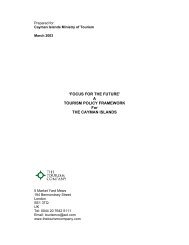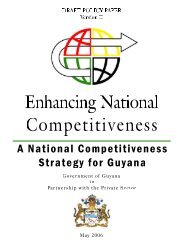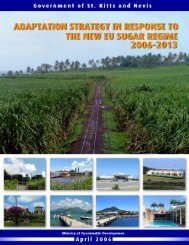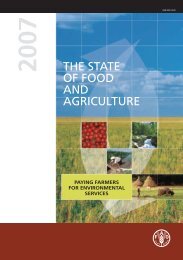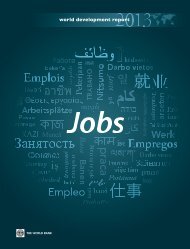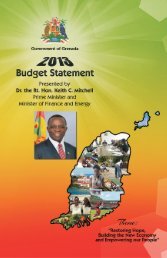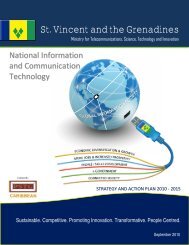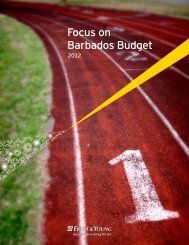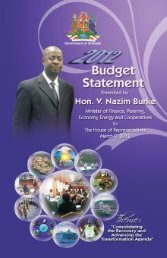Business Removing
Doing Business in 2005 -- Removing Obstacles to Growth
Doing Business in 2005 -- Removing Obstacles to Growth
- No tags were found...
Create successful ePaper yourself
Turn your PDF publications into a flip-book with our unique Google optimized e-Paper software.
40 DOING BUSINESS IN 2005<br />
FIGURE 5.8<br />
Easy property registration, more credit, more investment<br />
Private credit as a percentage of GDP<br />
8<br />
Private investment as a percentage of GDP<br />
20<br />
6<br />
4<br />
15<br />
2<br />
0<br />
Most difficult<br />
Least difficult<br />
Countries ranked by ease of property registration, quintiles<br />
Most difficult<br />
Least difficult<br />
Countries ranked by ease of property registration, quintiles<br />
Note: Relationships with private credit remain significant at the 1% level when controlling for income, contract enforcement, and GDP growth, at the 10% level for investment when controlling for income.<br />
Source: Doing <strong>Business</strong> database, World Bank (2004).<br />
10<br />
With fewer assets in the formal sector, more entrepreneurs<br />
are excluded from using property as collateral,<br />
and less credit is allocated (figure 5.8). The possibility of<br />
getting loans is the only reason to take on the daunting<br />
task of registering in some countries. Banks in Rwanda<br />
will even assign staff to assist in the registration process<br />
so that they can take property as collateral. But when it<br />
is too difficult, few bother. Entrepreneurs will invest less<br />
if their property rights are less secure. Inefficient registration<br />
is associated with lower rates of private investment<br />
(figure 5.8). And it leads to lower productivity,<br />
since it is harder for property to be transferred from less<br />
to more productive uses. The result is slower growth.<br />
One study estimates that restrictive land market regulations<br />
cost 1.3% of annual economic growth in India. 21<br />
Notes<br />
1. UNRCC (2004).<br />
2. Ibbotson, Siegal and Love (1985). This chapter focuses on registering<br />
real property. See chapter 5 on registering movable property as<br />
collateral.<br />
3. More effective collateral laws would encourage greater use of<br />
movable assets as collateral, as discussed in the next chapter.<br />
4. World Bank Group Investment Climate Assessments (various).<br />
Available at: http://www.worldbank.org/privatesector/ic/ic_<br />
country_report.htm<br />
5. See Deininger (2003) for a summary.<br />
6. World Bank Group Investment Climate Assessments (various).<br />
Available at: http://www.worldbank.org/privatesector/ic/ic_<br />
country_report.htm<br />
7. Deininger (2003).<br />
8. Durand-Lasserve and Royston (2002).<br />
9. Fields (2002).<br />
10. Based on analysis of the Doing <strong>Business</strong> indicators with firm level<br />
data on the perceived security of property rights, as reported in<br />
Batra and others (2003).<br />
11. World Bank (2002).<br />
12. Land Equity International (2003).<br />
13. In Moldova and Ukraine the expedited procedure does not cut total<br />
time because they are performed simultaneously with procedures<br />
that take a longer time.<br />
14. Anderson-Saito and Dhar (2004).<br />
15. Ellis (2004).<br />
16. Fafchamps and Quisumbing (2002), Katz and Chamorro (2002).<br />
17. Knack and Keefer (1995), Besley (1995), Claessens and Laeven<br />
(2003), see Deininger (2003) for a summary and analysis of relevant<br />
studies.<br />
18. Based on analysis of 15,561 firms in 41 countries as reported in<br />
World Bank Investment Climate Assessments.<br />
19. Based on estimated dispute rates provided by property registries<br />
and lawyers as a part of the Doing <strong>Business</strong> survey.<br />
20. World Bank Group Investment Climate Assessments (various).<br />
Available at: http://www.worldbank.org/privatesector/ic/ic_<br />
country_report.htm<br />
21. McKinsey and Company (2001).



